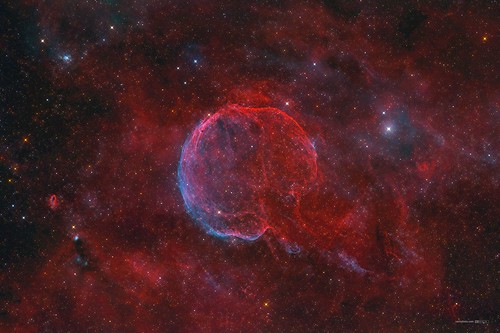 CTB-1 Supernova remnant in Cassiopeia (Abell 85)
CTB-1 Supernova remnant in Cassiopeia (Abell 85) by
Jose Carballada, on Flickr
This picture is the result of an integration of 6 hours on RGB and another 54 hours in narrow band, using a focal length of 530mm and aperture f3.3
It was a long project in terms of acquisition period, five months of capturing frames from September 2022 to January 2023, only on nights with no moon.
The elaboration was a little bit more complex as usual due the high number of stars on the frame.

RGB master
I really like how this Epsilon shows all fine details and structures on the nebulae, and how PK116+00.1 is properly defined.
CTB 1 is a supernova remnant located in the Milky Way galaxy.
It is thought to be the remnants of a massive star that underwent a supernova explosion, expelling its outer layers into the interstellar medium and leaving behind a compact object such as a neutron star or a black hole.Supernova remnants are important because they help us to understand the evolution of stars and the processes involved in supernovae.
They also release large amounts of matter and energy into the interstellar medium, which can have a significant impact on their surroundings.
CTB 1 was discovered in the late 1970s and has been the subject of numerous studies since then. These studies have helped to improve our understanding of the structure, dynamics, and evolution of supernova remnants, as well as the properties of the supernova explosions themselves.
It is believed that CTB 1 is relatively young, with an estimated age of only a few thousand years. This makes it an important object for studying the early stages of the evolution of supernova remnants, and for understanding the processes involved in their formation and evolution.
All technical details of the capture on the photo post.
[url=https://flic.kr/p/2ojbK8H][img]https://live.staticflickr.com/65535/52714334587_30bbe3bf12.jpg[/img][/url]
[url=https://flic.kr/p/2ojbK8H]CTB-1 Supernova remnant in Cassiopeia (Abell 85)[/url] by [url=https://www.flickr.com/photos/carballada/]Jose Carballada[/url], on Flickr
This picture is the result of an integration of 6 hours on RGB and another 54 hours in narrow band, using a focal length of 530mm and aperture f3.3
It was a long project in terms of acquisition period, five months of capturing frames from September 2022 to January 2023, only on nights with no moon.
The elaboration was a little bit more complex as usual due the high number of stars on the frame.
[img]https://cdn.astrobin.com/ckeditor-files/19267/2023/08484e09-ddb8-4332-81e4-588ae8d6b3ec.jpg[/img]
RGB master
I really like how this Epsilon shows all fine details and structures on the nebulae, and how PK116+00.1 is properly defined.
CTB 1 is a supernova remnant located in the Milky Way galaxy.
It is thought to be the remnants of a massive star that underwent a supernova explosion, expelling its outer layers into the interstellar medium and leaving behind a compact object such as a neutron star or a black hole.Supernova remnants are important because they help us to understand the evolution of stars and the processes involved in supernovae.
They also release large amounts of matter and energy into the interstellar medium, which can have a significant impact on their surroundings.
CTB 1 was discovered in the late 1970s and has been the subject of numerous studies since then. These studies have helped to improve our understanding of the structure, dynamics, and evolution of supernova remnants, as well as the properties of the supernova explosions themselves.
It is believed that CTB 1 is relatively young, with an estimated age of only a few thousand years. This makes it an important object for studying the early stages of the evolution of supernova remnants, and for understanding the processes involved in their formation and evolution.
All technical details of the capture on the photo post.